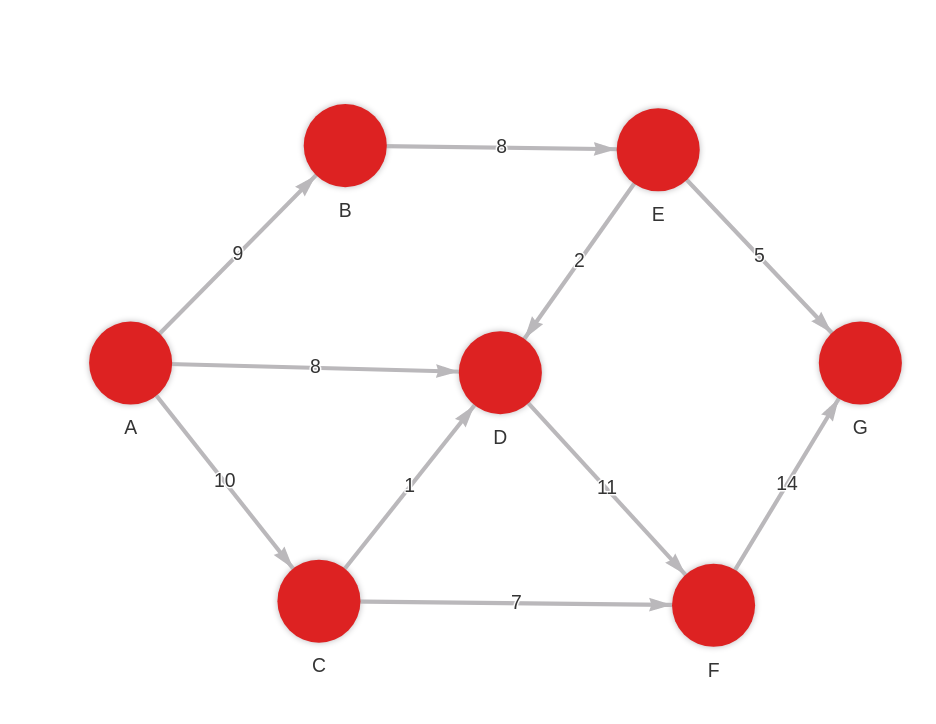max_flow
The maximum flow problem consists of finding a flow through a graph such that it is the maximum possible flow.
The algorithm implementation is based on the Ford-Fulkerson method with capacity scaling. Ford-Fulkerson method is not itself an algorithm as it does not specify the procedure of finding augmenting paths in a residual graph. It is a greedy method, using augmenting paths as it comes across them. Input is a weighted graph with a defined source and sink, representing the beginning and end of the flow network. The algorithm begins with an empty flow and, at each step, finds a path, called an augmenting path, from the source to the sink that generates more flow. When flow cannot be increased anymore, the algorithm stops, and the maximum flow has been found.
The capacity scaling is a heuristic for finding augmenting paths in such a way that prioritizes taking edges with larger capacities, maintaining a threshold value that is only lowered once no larger path can be found. It speeds up the algorithm noticeably compared to a standard DFS search.
The algorithm is adapted to work with heterogeneous graphs, meaning not all edges need to have the defined edge property used for edge flow. When an edge doesn't have a flow, it is skipped, and when no edges have this property, the returning max flow value is 0.
| Trait | Value |
|---|---|
| Module type | algorithm |
| Implementation | Python |
| Graph direction | directed |
| Edge weights | weighted |
| Parallelism | sequential |
If this algorithm implementation is too slow for your use case, contact us and request a rewrite to C++ !
Procedures
If you want to execute this algorithm on graph projections, subgraphs or portions of the graph, be sure to check out the guide on How to run a MAGE module on subgraphs.
get_flow(parameters, edge_property)
Input:
start_v: Vertex➡ Source node from which the maximum flow is calculatedend_v: Vertex➡ Sink node to which the max flow is calculatededge_property: string (default="weight")➡ Edge property which is used as the flow capacity of the edge
Output:
max_flow: Number➡ Maximum flow of the network, from source to sink
Usage:
MATCH (source {id: 0}), (sink {id: 5})
CALL max_flow.get_flow(source, sink, "weight")
YIELD max_flow
RETURN max_flow;
get_paths(parameters, edge_property)
Input:
start_v: Vertex➡ Source node from which the maximum flow is calculatedend_v: Vertex➡ Sink node to which the max flow is calculatededge_property: string (default="weight")➡ Edge property which is used as the flow capacity of the edge
Output:
path: Path➡ path with a flow in a maximum flowflow: Number➡ flow amount corresponding to that path
Usage:
MATCH (source {id: 0}), (sink {id: 5})
CALL max_flow.get_paths(source, sink, "weight")
YIELD path, flow
RETURN path, flow;
Example
- Step 1: Input graph
- Step 2: Cypher load commands
- Step 3: Running command
- Step 4: Results

MERGE (a:Node {id: "A"}) MERGE (b:Node {id: "B"}) CREATE (a)-[:RELATION {weight: 9}]->(b);
MERGE (a:Node {id: "A"}) MERGE (b:Node {id: "C"}) CREATE (a)-[:RELATION {weight: 10}]->(b);
MERGE (a:Node {id: "B"}) MERGE (b:Node {id: "E"}) CREATE (a)-[:RELATION {weight: 8}]->(b);
MERGE (a:Node {id: "C"}) MERGE (b:Node {id: "F"}) CREATE (a)-[:RELATION {weight: 7}]->(b);
MERGE (a:Node {id: "C"}) MERGE (b:Node {id: "D"}) CREATE (a)-[:RELATION {weight: 1}]->(b);
MERGE (a:Node {id: "A"}) MERGE (b:Node {id: "D"}) CREATE (a)-[:RELATION {weight: 8}]->(b);
MERGE (a:Node {id: "E"}) MERGE (b:Node {id: "D"}) CREATE (a)-[:RELATION {weight: 2}]->(b);
MERGE (a:Node {id: "D"}) MERGE (b:Node {id: "F"}) CREATE (a)-[:RELATION {weight: 11}]->(b);
MERGE (a:Node {id: "E"}) MERGE (b:Node {id: "G"}) CREATE (a)-[:RELATION {weight: 5}]->(b);
MERGE (a:Node {id: "F"}) MERGE (b:Node {id: "G"}) CREATE (a)-[:RELATION {weight: 14}]->(b);
MATCH (source {id: "A"}), (sink {id: "G"})
CALL max_flow.get_flow(source, sink)
YIELD max_flow
RETURN max_flow;
+----------+
| max_flow |
+----------+
| 19 |
+----------+
